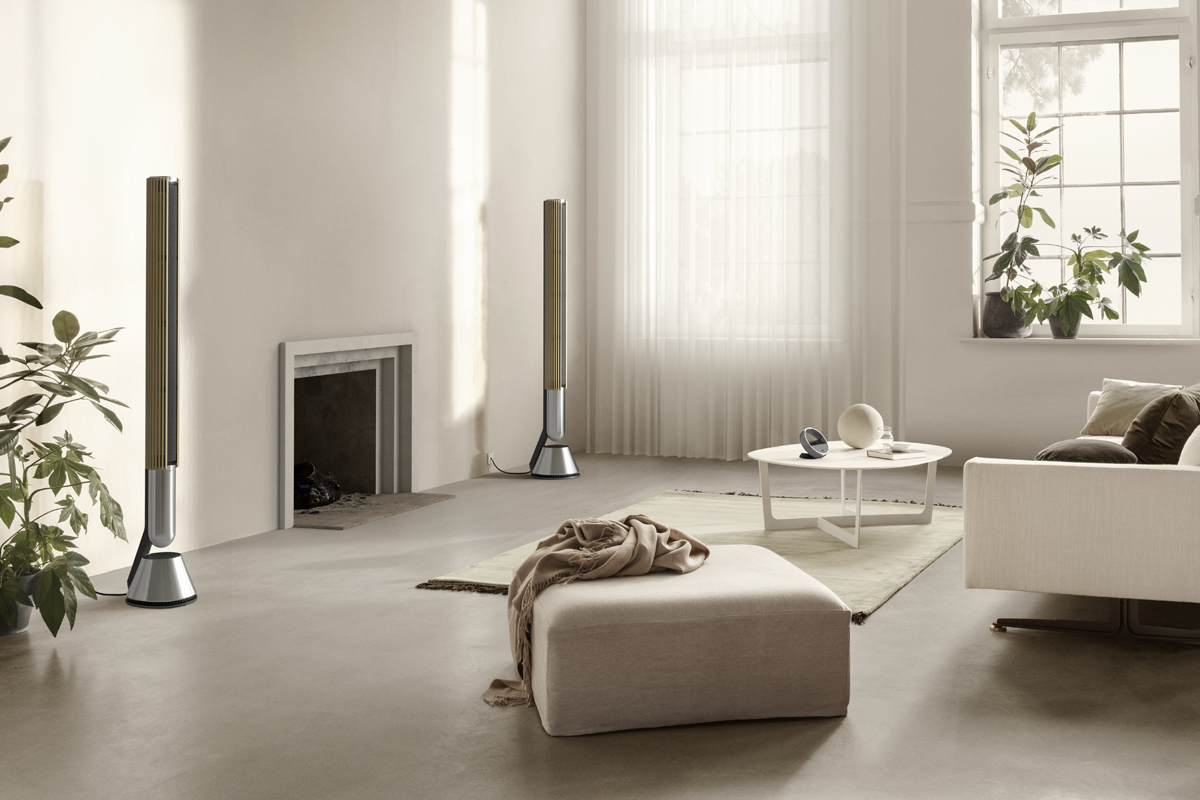 Is there an audio manufacturer whose products exemplify Simplifi’d hi-fi more than Denmark’s Bang & Olufsen? I doubt it. Formed in 1925, B&O started offering “convenient, lifestyle-oriented hi-fi” components not long after the word “lifestyle” had been coined.
Is there an audio manufacturer whose products exemplify Simplifi’d hi-fi more than Denmark’s Bang & Olufsen? I doubt it. Formed in 1925, B&O started offering “convenient, lifestyle-oriented hi-fi” components not long after the word “lifestyle” had been coined.
Bang & Olufsen has always been acclaimed for its creative industrial design. The new Beolab 28 active loudspeaker is a case in point. A column-shaped module appears to float in the air above an aluminum base that houses the woofer. When you start playing music, cloth or slatted-wood “curtains” on the front of each speaker open, and the concert begins. The speakers can be placed on the floor or mounted on the wall.
The engineering behind the speaker is hardly less impressive. The Beolab 28 is a three-way design—a 6.5″ woofer, three 3″ full-range drivers, and a 1″ textile-dome tweeter—with a total of 625W of class-D amplification per speaker. Specified frequency range is 27Hz–23kHz (no deviation given), and maximum SPL is 110dB (per pair). The Beolab also has clever DSP functions to help overcome problems in real-world listening rooms and to adjust output for different listening situations; and a network streamer that supports Apple AirPlay 2, Google Chromecast, Spotify Connect, and UPnP/DLNA.
Outside . . .
For my review, Bang & Olufsen supplied the floorstanding version of the Beolab 28, which has a circular footprint, 10″ in diameter, and is 54″ tall. The wall-mounted version measures 8.3″D × 10″W × 55.1″H. Both versions weigh 41 pounds.
Floating above the aluminum woofer module is a tall, narrow column containing the electronics, full-range drivers, and tweeter. The electronics are in a capsule-shaped aluminum section at the bottom of the column, and the drivers are behind a fabric cover in the top section. On the front of the upper section is a two-piece arced outer cover—or “curtains,” as B&O calls this element—of slatted wood on some models, woven fabric on others. The curtains open as soon as music begins playing, and shut again when the music stops.
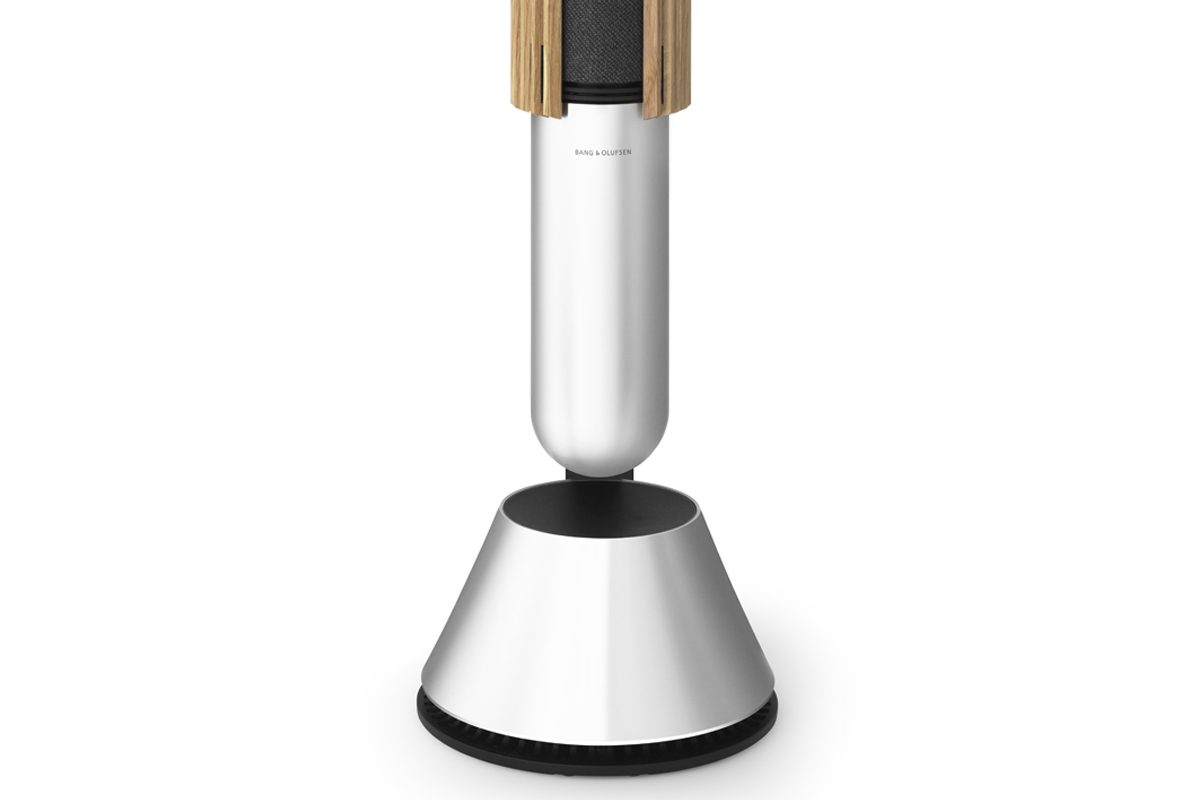
The base of the speaker is shaped like a truncated cone, with a gap around the lower perimeter that allows sound from the woofer to vent into the room. With the floorstanding version, the base sits on the floor and the woofer fires downward. With the wall-mounted version, the base attaches to the wall, with the main module rising perpendicularly from it, so the woofer fires backward. The main difference between the wall-mounted and floorstanding versions is the backbone that attaches the woofer module to the main module—the drivers and electronics are the same.
The Light Oak floorstanding version, which I tested, had slatted wood outer covers and a gray fabric inner cover. The aluminum of the bass module and the electronics section of the main module was in the Natural finish. It hardly needs saying that the Light Oak Beolabs looked drop-dead gorgeous in my living room—the materials, design, and craftsmanship were all impeccable.
Purchasers can customize the Beolab 28 to suit their décor. For the base and electronics sections, they can choose from a range of anodized finishes: Natural, Bronze Tone, or Black Anthracite. For the upper section containing the full-range drivers, they can choose a slatted Light Oak outer cover with a fabric inner cover in Grey; a slatted Smoked Oak outer cover with a darker, Grey Mélange fabric inner cover; a slatted Walnut outer cover with Grey Mélange inner cover; Grey Mélange fabric outer and inner covers; or the lighter Grey fabric inner and outer covers. The versions with slatted wood outer covers sell for $16,500/pair (all prices in USD); those with fabric outer covers are $14,750/pair.
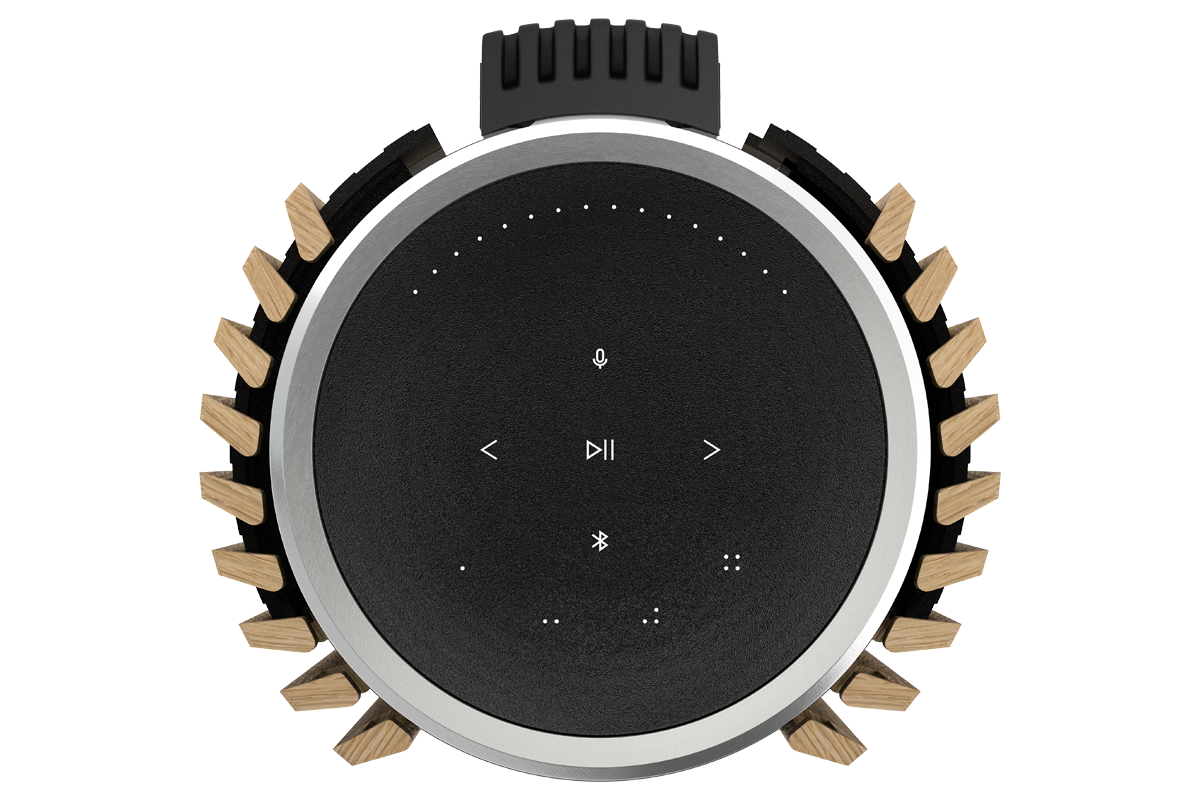
On the top of each speaker is a glass control panel with a proximity sensor, so that it lights up when you approach it. Using touch controls, you can adjust volume, pause and resume playback, skip tracks forward or backward, enable or disable Bluetooth, and select one of four presets. A preset can be a favorite internet radio station or a Spotify playlist, and can be programmed using the Bang & Olufsen app, which is available for iOS and Android.
. . . and inside
The Beolab 28 is a fully active system, with separate amplifiers for each driver and a crossover implemented by a digital signal processor. Each speaker contains a 6.5″ paper-cone woofer powered by a 225W class-D amp; three 3″ paper-cone “full-range” drivers, each with its own 100W class-D amp; and a 1″ textile-dome tweeter, also powered by a 100W class-D amp. The woofer and full-range drivers have ferrite magnets; the tweeter has a neodymium magnet.
Not surprisingly, the Beolab 28’s “full-range” drivers don’t cover the full audioband. To protect them from damage, the DSP applies a high-pass filter at 200Hz; and depending on user-controllable DSP settings, may apply a low-pass filter at 4kHz.
Hidden behind the fabric inner cover of each speaker is a jack panel with a 3.5mm combined line-level analog/TosLink S/PDIF autosensing stereo input, two Ethernet ports, and USB-C and USB-A service ports. The Beolabs can connect wirelessly to a Beovision TV using B&O’s Wireless Power Link protocol, but there’s also a PowerLink port for a wired connection to a B&O television.
External components can only be connected to one of the speakers in a pair. During setup, you specify whether the left or right speaker should serve as the primary speaker.
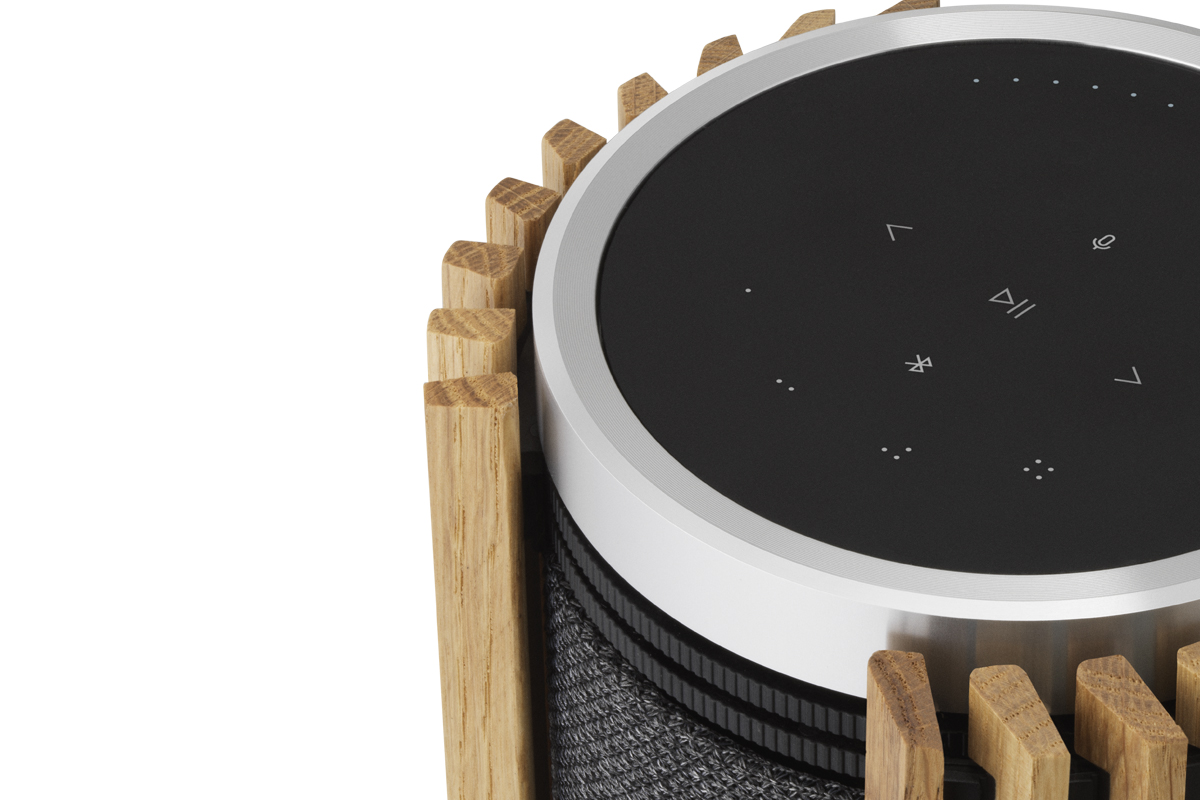
The Beolab 28 has built-in Bluetooth and Wi-Fi, and supports Apple AirPlay 2, Chromecast, Spotify Connect, and UPnP/DLNA. There are three options for connecting a pair of Beolabs to your home network and the internet: connect an Ethernet port on both speakers directly to a router or access point; connect an Ethernet port of one speaker to a router or access point, and use a second Ethernet cable to daisy-chain the other Ethernet port to the second speaker; or set up a Wi-Fi connection on your primary speaker, which will send audio wirelessly to the secondary speaker. By default, the Beolabs use Fraunhofer’s LC3plus codec to move audio from one speaker to another. But there is a setting in the Bang & Olufsen app for sending uncompressed 24-bit/48kHz PCM audio from the primary to the secondary speaker. I enabled this option and did not experience any hiccups or dropouts during my testing.
One attractive bit of future-proofing: the Beolabs’ streaming board can be removed and replaced whenever B&O updates this section.
In addition to implementing the active crossover, the DSP compensates for non-linearities in the drivers to achieve smoother response and better time-domain behavior. The DSP also monitors the drivers and amplifiers, and when necessary, adjusts output to protect the speakers from overdriving, amplifier clipping, power-supply overload, and overheating.
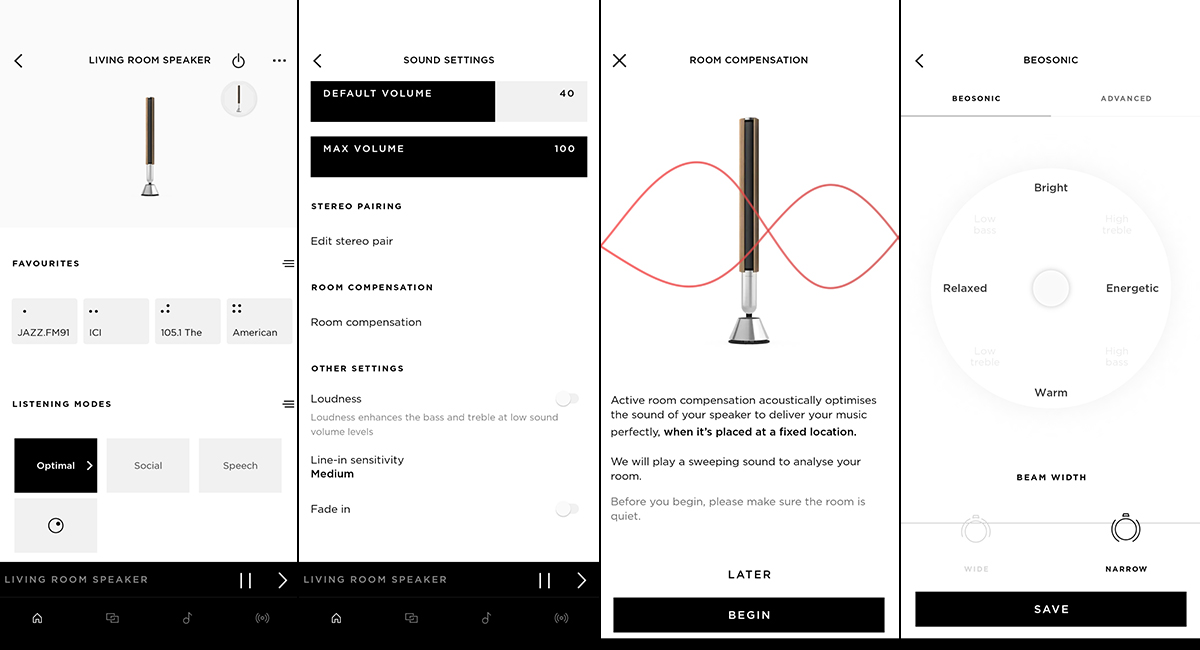
There are several user-controllable DSP functions: Active Room Compensation (ARC), Beam Width Control, Beosonic sound tuning, and bass and treble controls.
ARC optimizes low-frequency output to compensate for problematic acoustics and less-than-optimal speaker placement. This function is activated during the setup process. Each speaker plays a frequency sweep, and output is detected by its built-in microphone and analyzed by the DSP. The DSP then applies a correction curve to compensate for room problems. This feature is on by default, but it can be turned off in the Bang & Olufsen app. You can also use the app to recalibrate the speakers if, for example, you move them to another location or change the layout of your listening room.
Beam Width Control lets users adjust the speakers’ directivity. Intended for serious sit-down listening, Narrow mode limits reflections of mids and highs from room boundaries, focusing sound on the sweet spot. Intended for social and casual listening, Wide mode directs more sound to the sides, allowing for more room reflections. Beam Width Control works by manipulating the phase and amplitude of the signals sent to each of the three full-range drivers. In Wide mode, the DSP also applies a 4kHz low-pass filter to the signal sent to the three drivers. The curtains on each speaker reflect your selection, opening wider in Wide mode, and less so in Narrow mode—very cool!
Other DSP functions include three programmable preset listening modes (Optimal, Social, and Speech); Beosonic, which lets listeners adjust the speaker’s sonic signature between Warm, Bright, Relaxed, and Energetic; and bass/treble controls.
Setup and software
Each Beolab 28 ships in four cartons: one containing the main module that houses the electronics, full-range drivers, and tweeter; another carton containing the woofer module; a third containing the “curtains”; and the last containing the bracket that attaches the base to the main module.
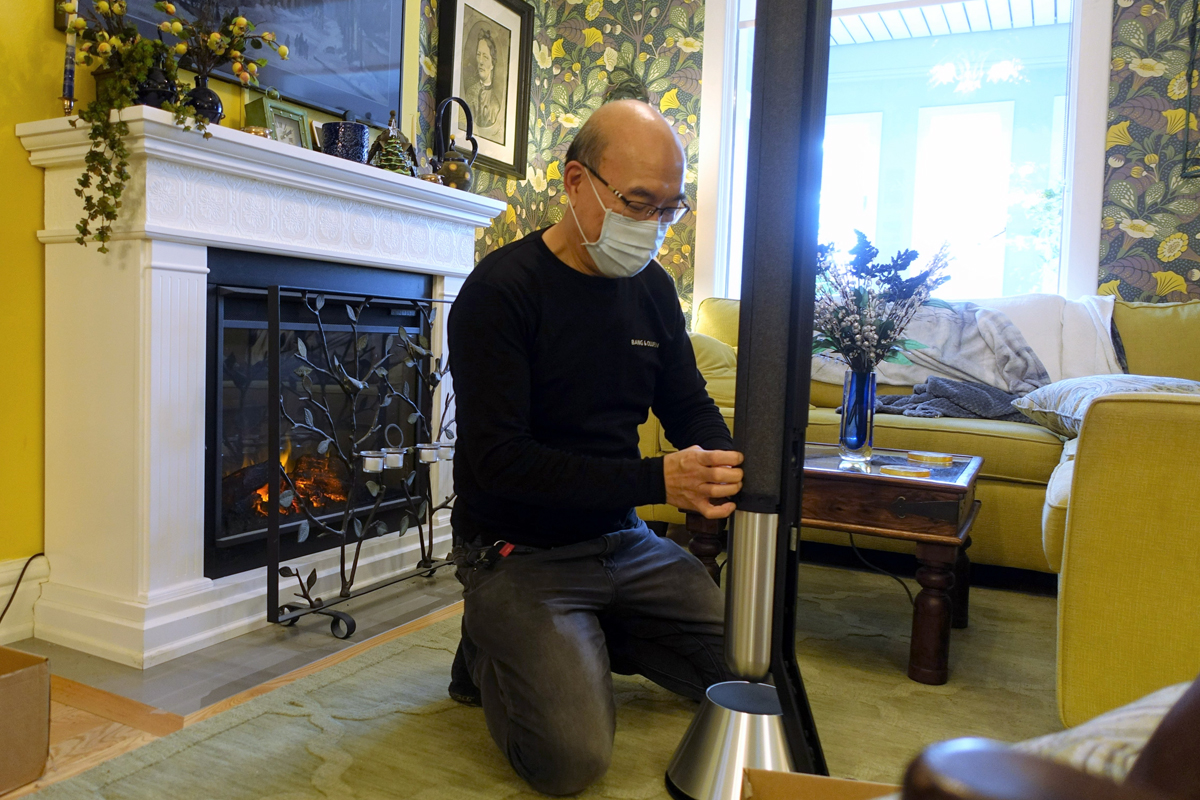
In early December, a pair of Beolab 28s were delivered to my home by Ermy Ju, a project consultant for Avaworks Inc., a Bang & Olufsen dealer in Markham, Ontario, northeast of Toronto. I didn’t have to unpack the eight cartons or assemble the speakers—Ju handled all of that. It took him about 30 minutes. Ju told me that B&O dealers routinely provide this white-glove service to Beolab 28 purchasers. With the wall-mount version, setup is always performed by the dealer, Ju added.
Along with the Beolab speakers, Ju brought a Beoremote Halo tabletop controller. Priced at $900, the Halo lets you adjust volume, pause and resume playback, skip tracks, and initiate playback from preset internet radio stations and Spotify playlists on the Beolabs. The LCD touchscreen in the center displays metadata, like artist name, album name, song name, and streaming protocol. You adjust volume with a weighted aluminum wheel along the perimeter. Like the Beolab 28 speakers, the Halo oozes class and quality. My sample had the Natural aluminum finish; B&O also offers Gold Tone, Bronze Tone, Brass Tone, and Black Anthracite finishes. Wall-mounted versions are available by special order. Bang & Olufsen dealers can also program the Halo to control smart-home functions like lighting, shades, and climate control.
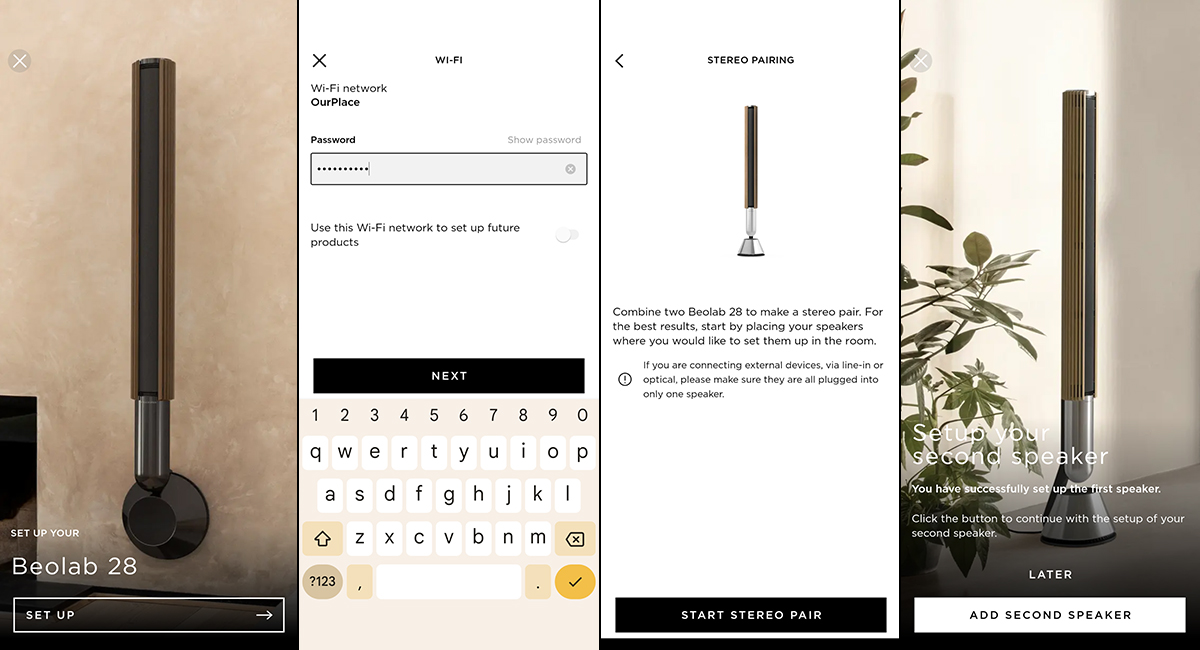
After Ju had assembled the two speakers, the next step was to get them on my home network. Per Ju’s instructions, I downloaded the Bang & Olufsen app to my Google Pixel 4a smartphone. The app prompted me to set up a Bang & Olufsen account. After I had done that, the app asked for permission to use the device’s location, then found the speakers and Halo. The app presented instructions for assembling the speakers, but as Ju had already done this for me, I skipped this bit. Next, it showed a list of available Wi-Fi networks. I selected mine, and entered my password on the next screen. The app uploaded network information to the primary speaker, then asked if I wanted to use this information to configure future B&O products—I did. The app downloaded a firmware update to the speaker, asked me to confirm the color of the speakers, so they’d be displayed correctly in the app, and set up the second speaker. After that was done, I confirmed which speaker would serve as the primary speaker, and then set up ARC. Finally, the app offered to show a tutorial on pairing the speakers with a Beovision TV, ran through a basic tutorial, and opened the Google Home app so I could enable Chromecast support. There was one last step—configuring the Halo to control the Beolabs. Like the rest of the setup process, that went smoothly.
After initial setup, you may not use the Bang & Olufsen app much on a day-to-day basis. As the Beolabs support AirPlay 2, you can stream directly to the Beolabs from any audio app on an iOS device. You can cue up music in the Spotify app on a computer or mobile device, then use Spotify Connect to transfer playback to the Beolabs. You can use Chromecast to send audio from any Cast-enabled app.
Of course, you need the app to change DSP settings, like Beam Width Control. And the Bang & Olufsen app also has internet radio function plus integrated support for the Deezer streaming service. If you want to use any other service, you’ll have to use that service’s own app on a computer or smart device.
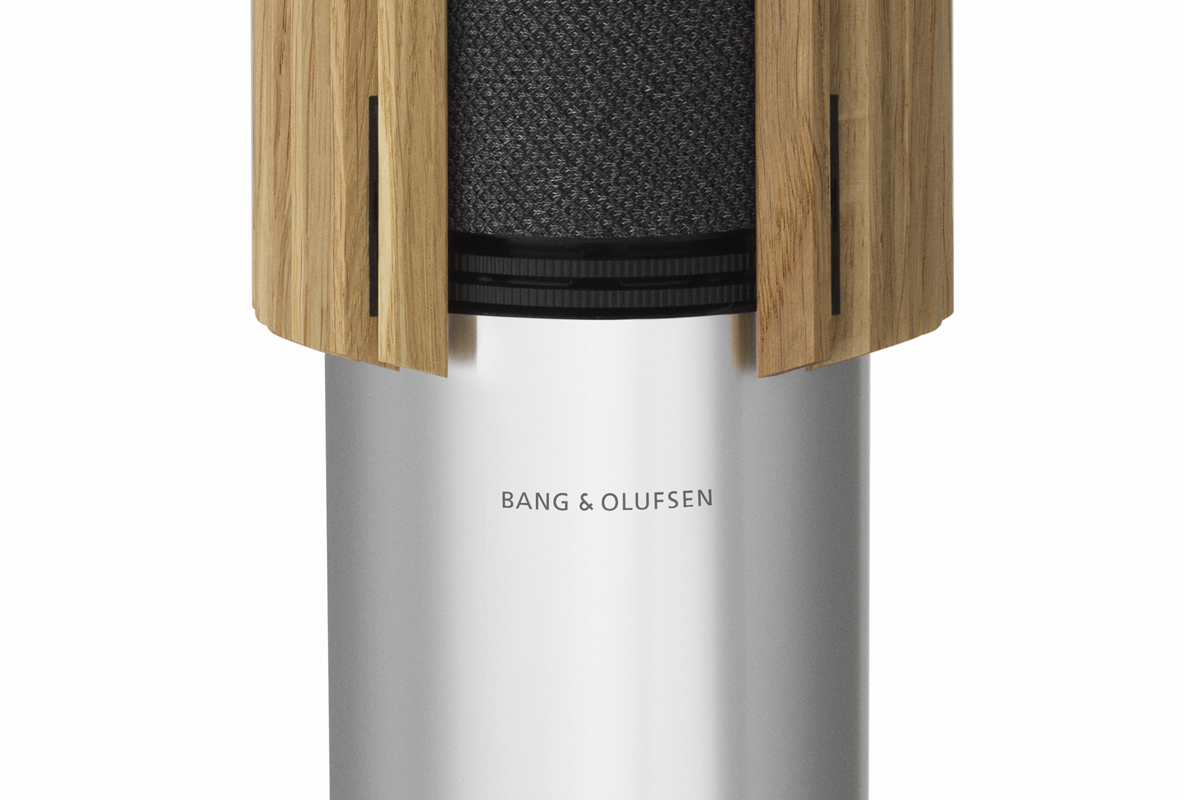
During my listening, I streamed music from my iPhone 8 via AirPlay, from the Spotify app on my Google Pixel phone via Spotify Connect, from Audirvana music-management software on my HP Spectre x360 convertible laptop via UPnP/DLNA, and from the Apple Mac Mini computer in my second-floor office, which runs Roon Core 1.8 music-management software.
The Beolabs aren’t Roon Ready, but you can stream to them from Roon using AirPlay or Chromecast. When streaming to the Beolabs via Chromecast, Roon sends 16-bit/44.1kHz, 24/44.1, 16/48, and 24/48 streams natively; higher-resolution files are downsampled to 24/44.1 or 24/48. When streaming via AirPlay, Roon sends everything at CD resolution—16/44.1.
I experienced only one bit of weirdness. The Halo didn’t show metadata when I sent music from my Roon music library via Chromecast; other than that, everything worked fine.
Listening
After assembling the Beolab 28s, Ermy Ju had placed them on either side of the electric fireplace in the living room of my Toronto home. They were 7ʹ apart, and 7ʹ from the sweet spot on the end cushion of the sectional sofa on the opposite wall. The back edges of their main columns were 20″ from the front wall.
Before conducting serious sit-down listening, I experimented with a couple of the DSP options on the Beolabs.
Beam Width Control worked exactly as advertised. For social listening, Wide mode indeed gave a more integrated presentation for off-axis listeners, but imaging was more amorphous in the sweet spot. When Ju installed the speakers, he pointed them straight ahead, and even in Narrow mode, imaging was a touch vague. But toeing the speakers in slightly toward the listening position changed that completely. With that little tweak, imaging was commendably precise, but the soundstage was confined to the area between and behind the speakers.
Next, I compared the sound of the Beolabs with Active Room Compensation enabled and disabled. Without ARC, the sound of low double-bass notes was thuddy and indistinct; the result of some nasty standing waves in my listening room. My living room has a 9ʹ ceiling. The distance from the front to the back wall is also 9ʹ. That’s not a huge issue for the left speaker, which faces a small doorway. But with the right speaker, those identical dimensions represent a worst-case scenario. They cause a nasty peak at 62Hz—hence that thuddy, indistinct bass. ARC tightened up the bass considerably, but not completely.
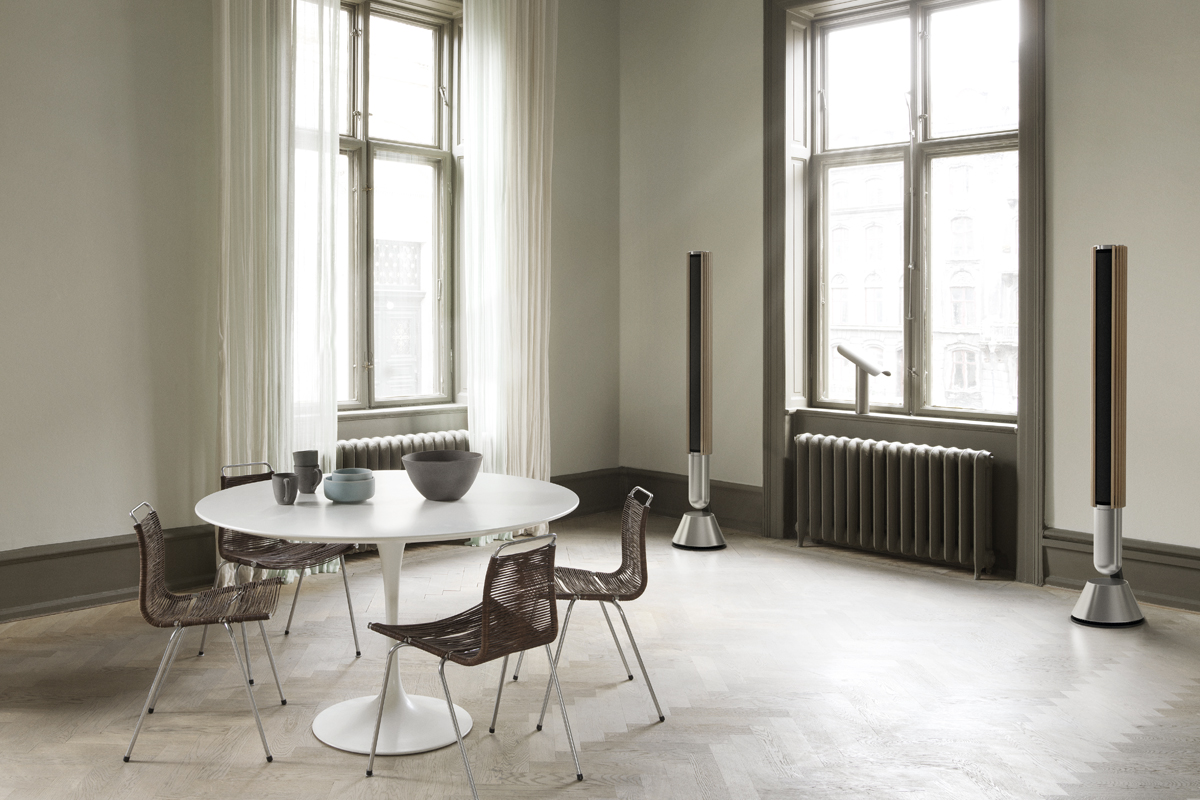
For my listening tests, I set Beam Width Control to Narrow mode and enabled ARC, and listened from the sweet spot on my sofa. All music was streamed to the Beolab speakers via Chromecast from the Mac Mini which serves as my Roon server.
Several characteristics emerged throughout my listening:
- The sound was consistently fluid and inviting, but also dynamic and exciting.
- While ARC did not entirely overcome the bass modes in my listening room, timbres were commendably natural from the upper bass to extreme highs, and the presentation was wonderfully coherent. This was especially noticeable with voices, which sounded embodied and three-dimensional.
- Dynamics were superb. I was constantly amazed by how readily these speakers scaled from pianissimo to fortissimo, and how naturally they resolved gradations between these extremes.
- Microdetail was wonderful. With voices, consonants and sibilants were clear but not exaggerated. I could visualize the way singers were using their lips and mouths to form words.
I started with Patricia Barber’s “Trouble Is a Man,” from Clique (24-bit/352kHz FLAC, Impex Records/Qobuz; downsampled by Roon to 24/44.1 for Chromecast streaming). This track from her superbly recorded album of jazz standards sounded wonderful through the Beolabs. On the right side of the soundstage, Patrick Mulcahy’s double-bass plucks were crisp and well defined, without being exaggerated, and were followed by extended woody decays. However, the lowest notes sounded a little thuddy and indistinct. Through the Beolabs, every piece of Jon Deitemyer’s drum kit sounded ideal. His floor tom had great palpability; taps on the wood block were fast and crisp, and you could really hear its woodiness; and the cymbals had wonderful metallic shimmer, with no splashiness whatsoever.
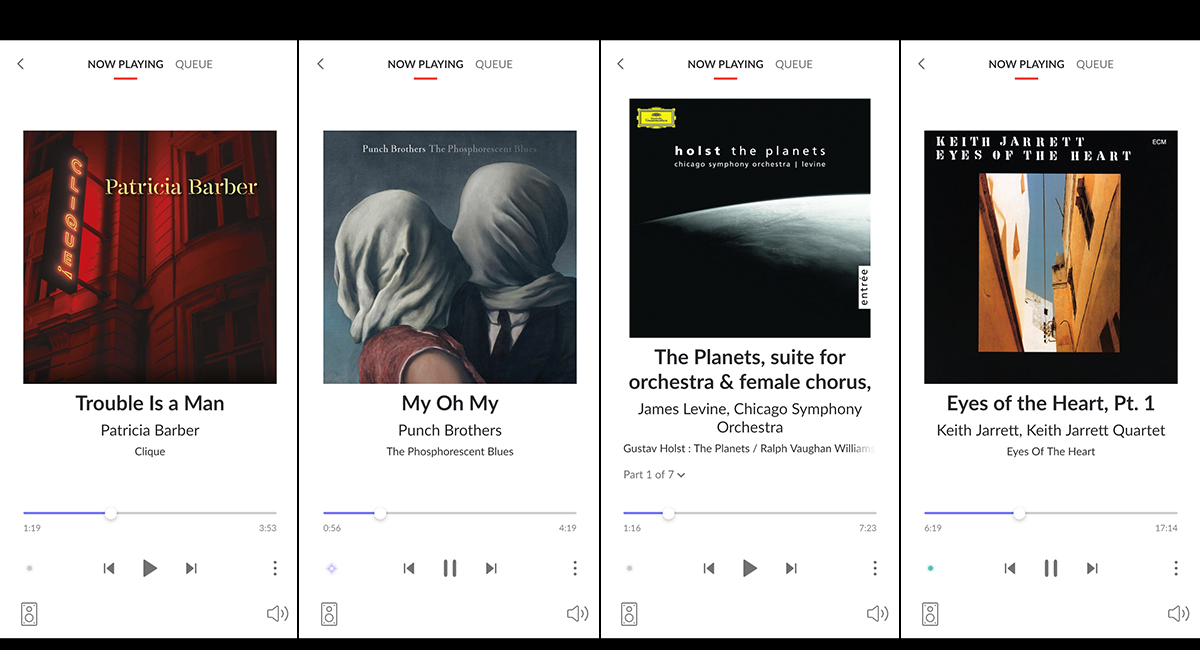
I loved the way the Beolabs tracked Barber’s legato piano chords. I could sense the way she varied pressure on the keys. Piano tone was ideal—just the right amount of sparkle up top, and admirable authority down low. Barber’s vocals, locked in the front center of the soundstage, sounded fully realized—I heard the person, not just a voice. The Beolabs presented Barber’s whispery, quivery inflections beautifully, highlighting the sadness of the song’s mood.
The Danish speakers were just as convincing with Chris Thile’s nasal tenor, and the harmonizing of his bandmates, in the joyous “My Oh My” from Punch Brothers’ The Phosphorescent Blues (16/44.1 FLAC, Nonesuch Records/Qobuz). I heard no coloration whatsoever in Thile’s normal tenor range or in his falsetto singing. Again, the Beolabs tracked his singing perfectly, nailing the slightly whispery delivery of “My, oh my, what a wonderful day we’re having” in the first chorus, and his exuberance when he belts out “Let freedom vibrate, not ring” in the second verse.
The transients of Thile’s mandolin in the center, Noam Pikelny’s banjo on the right, and Chris Eldridge’s acoustic guitar in the center left were fast and exciting, but not overemphasized. The upper strings of Thile’s mandolin had a lovely ringing tone, and Pikelny’s banjo twanged convincingly. With all these instruments, transients segued into resonances that revealed the varied sizes of the instruments’ bodies. The Beolabs presented these details as integrated musical events, instead of separating them into discrete sounds. The speakers were just as convincing with Gabe Witcher’s fiddle, which sounded rich and rosiny, and not at all squeaky. As with “Trouble Is a Man,” the reproduction of lower bowed and plucked double-bass notes sounded a little boomy.
To hear how the Beolabs would perform with a dense, demanding orchestral score, I cued up a familiar classical warhorse: “Mars, the Bringer of War,” from Gustav Holst’s suite The Planets, from a thrilling 2004 release of a 1989 recording by the Chicago Symphony Orchestra, conducted by James Levine (16/44.1 FLAC, Deutsche Grammophon/Qobuz).
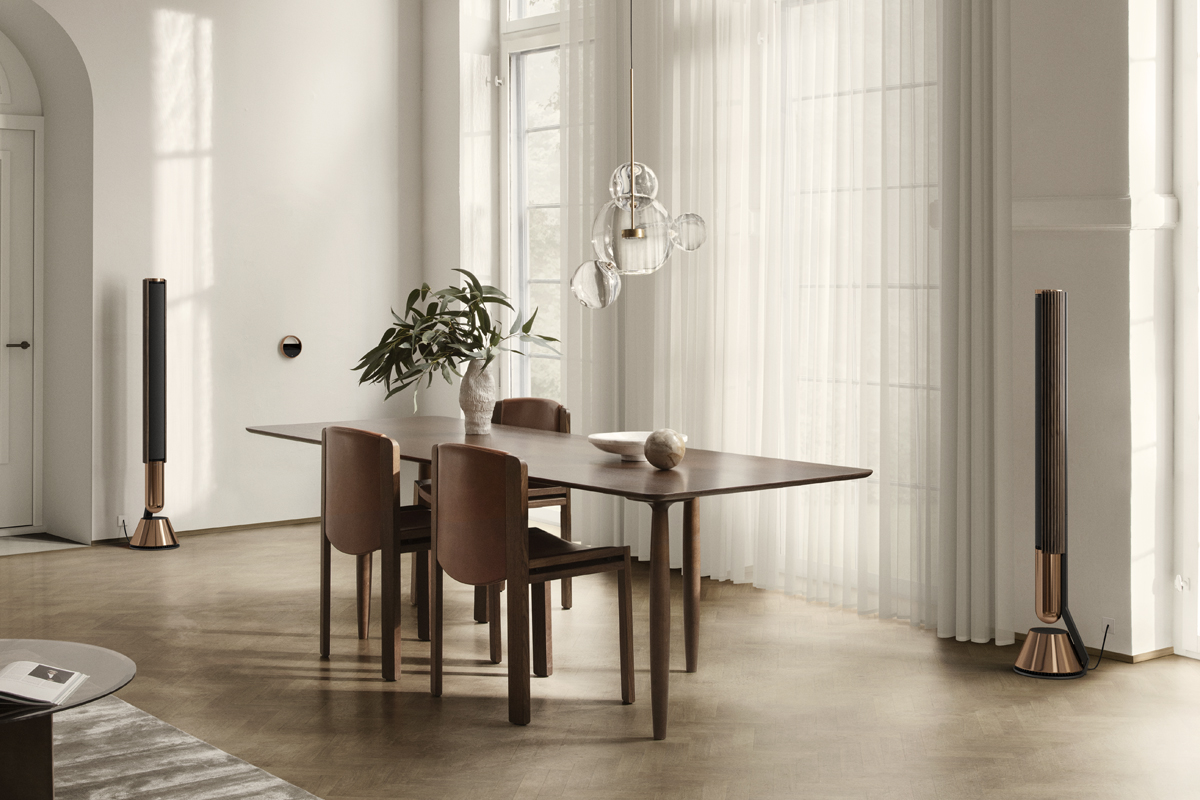
The movement opens quietly, with the whole string section playing col legno (striking the strings with the wooden backs of their bows). They beat out a fierce ostinato, while the brass instruments behind them play ominous two-note phrases. I was wowed by the transparent sound, and by the spot-on timbres of the brass instruments; they sounded bold and metallic, but never edgy. Lateral imaging and front-to-back layering were both excellent.
As the movement builds, more instruments join the fray—a shimmering metallic gong on the right rear, a pipe organ at the very back of the soundstage, followed by timpani and bass drums. The Beolabs scaled up effortlessly, producing the dense, dissonant middle section and shattering conclusion without a hint of distress or congestion. It was easy to follow different groups of instruments, all of them precisely located on a high, deep soundstage.
The bass drum and organ pedal notes were big and powerful—I could feel as well as hear them, which added to the sense of danger. But they also had a droning, thuddy quality. Especially during loud passages, it was hard to distinguish between organ pedal notes, low double-bass notes, and bass drum thwacks—it was like a big, bass blur. Seemingly, the Beolabs’ ARC function couldn’t fully counteract those bass modes in my living room.
Eyes of the Heart, a 1979 live album by Keith Jarrett’s American quartet (24/192 FLAC, ECM Records/Qobuz; downsampled by Roon to 24/48 for Chromecast streaming), showed off the Beolabs’ outstanding micro- and macrodynamics. “Eyes of the Heart (Part One)” begins with Charlie Haden playing muted double-bass notes on the right side of the soundstage, while Jarrett plays an OSI drum (a wooden tongue drum with tunable keys) in the center, drummer Paul Motian plays huge beats on the snare and floor tom along the rear, and Dewey Redman plays tambourine and maracas on the left. Each percussive instrument was located with admirable precision. The sharp impacts on the OSI drum, floor tom, and snare jumped into my room; the tambourine and maracas added some high-frequency spice. Transients were fast but not exaggerated.
Haden’s muted double-bass notes, all on the upper strings, sounded full and rich, with no objectionable bloat. However, later in the piece, when Haden plays pizzicato notes on the lower strings, the sound of his double bass became a little boomy.
Just past the two-minute mark, Jarrett enters on soprano sax, and the magic continued. The Beolabs conveyed every aspect of Jarrett’s blowing—his sharp toots, his subtle legato transitions—without artificially spotlighting them. The Beolabs were just as convincing on Redman’s long tenor-sax solo in “Part Two.” His squeaks and howls jumped out of the speakers. The Beolabs delineated his lightning-fast phrasing wonderfully. I could follow every detail of Redman’s breathing and phrasing, but these details weren’t exaggerated; they were completely natural.
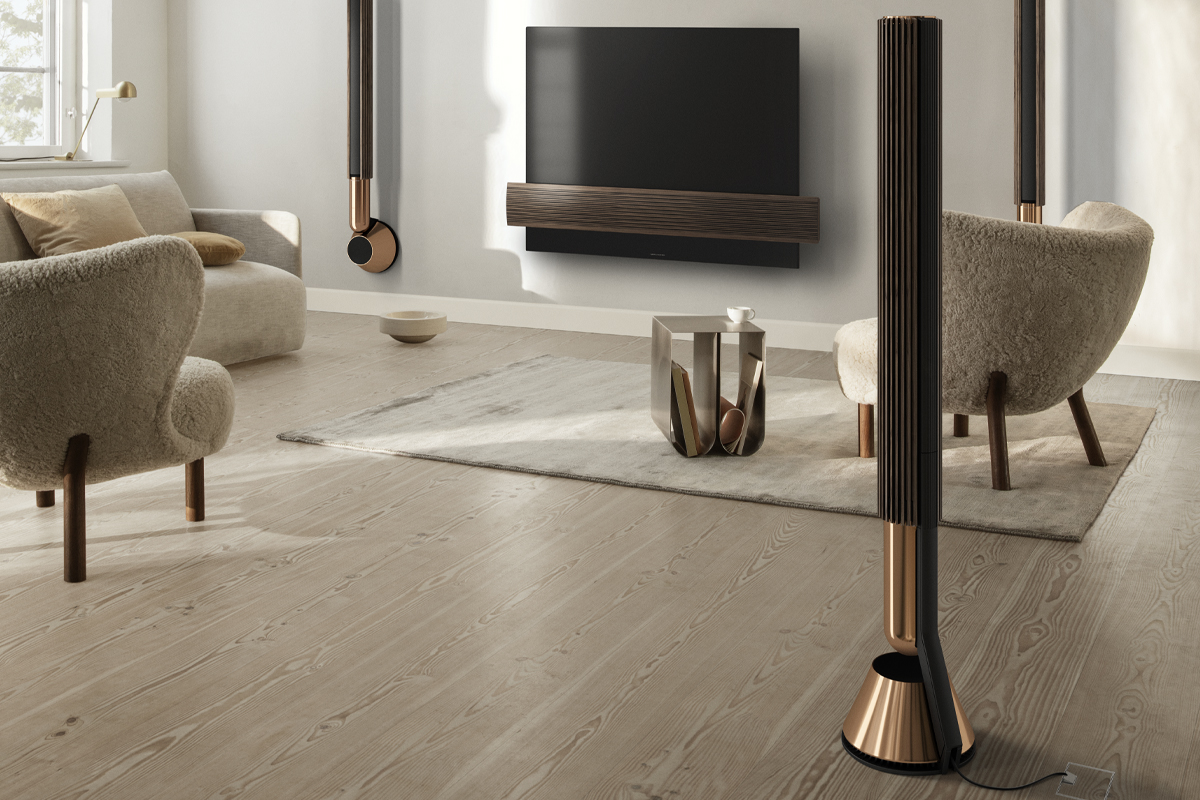
Around the eight-minute mark of “Part One,” Jarrett switches from soprano to piano, and more magic ensued. The piano tone was ideal. In quiet legato passages, the Beolabs showed off Jarrett’s wonderful tonal and dynamic shading; his big staccato notes and chords were explosive and effortless, and were followed by wonderful decays that evoked the Theater am Kornmarkt in Bregenz, Austria, where the concert took place in 1976.
Motian’s frenetic drumming sounded thrilling through the Beolabs. The sharp transients of stick against cymbal were fiercely metallic, but not at all strident or splashy. Brushed snare strokes had marvelous texture. The only negative was the sound of kickdrum, which was a little thuddy and indistinct—those room modes again!
Comparison
As the Beolab 28 is a unique product, there was no obvious competitor to serve as a comparison. So I used my own reference system: NAD C 658 streaming DAC-preamp ($1749), Elac Navis ARF-51 floorstanding active loudspeakers ($5399.96/pair) with IsoAcoustics Gaia II isolators ($299.99), and SVS 3000 Micro subwoofer ($899.99). One of the signature features of the NAD C 658 is Dirac Live room correction, which I enabled, reasoning that I was using the Beolabs’ own room-correction feature. I used the full-bandwidth version of Dirac, which costs an extra $99.
On “Trouble Is a Man,” Patricia Barber’s sibilants were a little more spitty through the NAD/Elac system, and Jon Deitemyer’s cymbals were more splashy. Deitemyer’s floor tom and Patrick Mulcahy’s double bass didn’t sound as rich and resonant, but they were better controlled, with less overhang and better pitch differentiation. Barber’s voice sounded slightly fuller and more embodied through the Danish speakers. The Elac/NAD system threw a wider, deeper soundstage than the Beolabs did—even in the Beolabs’ Narrow mode—and images were located a little more precisely.
The Elac/NAD system also created a vaster soundstage on “Mars, the Bringer of War” from The Planets, with slightly more precise imaging. Deep notes from double basses, bass drums, and pipe organ sounded more powerful through the Beolabs, giving a more impressive sense of scale. But those notes also hit plenty hard through the Elac/NAD combo; I could feel them in my legs and torso. More importantly, the bass was better defined through the Elacs and NAD, so that it was easier to differentiate low-pitched instruments when they were playing together. String tone in the violins was steelier with the Elac/NAD system, smoother and sweeter with the Beolabs.
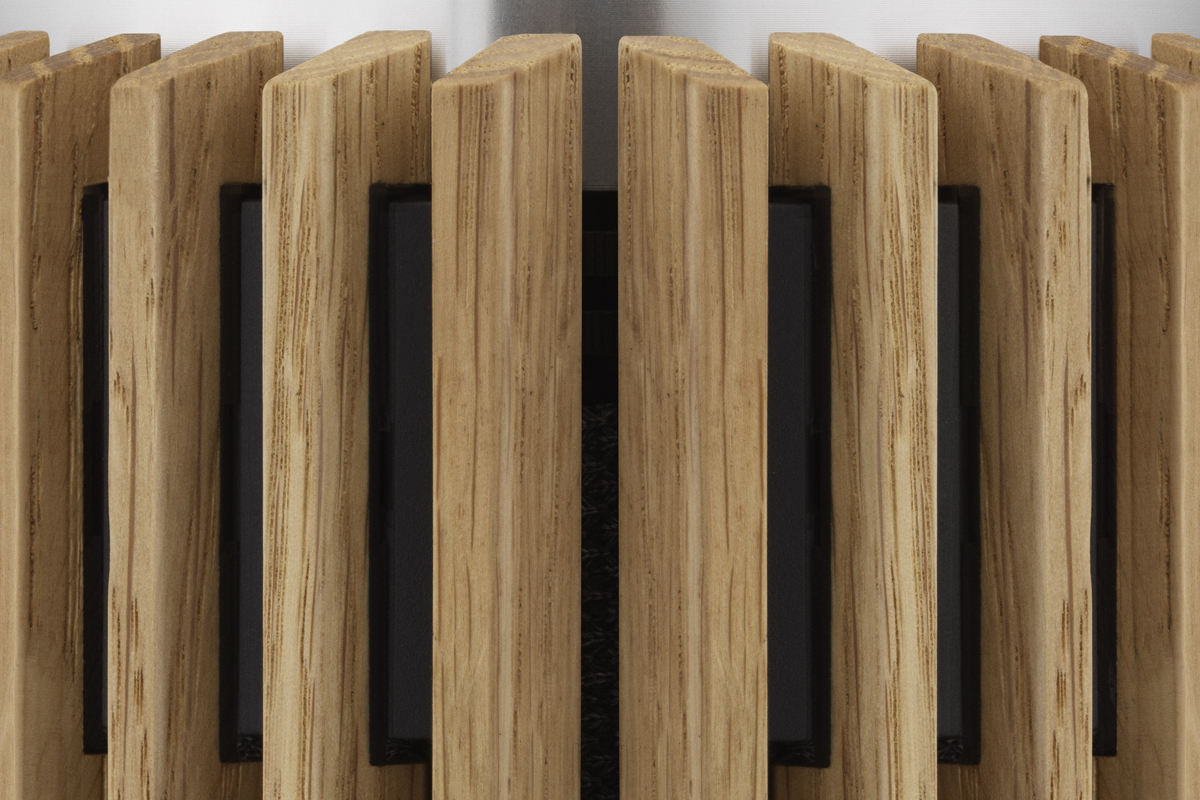
On Punch Brothers’ “My Oh My,” the transients of the mandolin, guitar, and banjo were more emphasized by the Elacs. However, I heard more of the woody resonance of the instruments’ bodies through the Beolabs, which I preferred. Similarly, the voices of Thile and his bandmates sounded a little fuller through the Beolabs. And once again, the double bass was better controlled with the Elac/NAD system—I didn’t hear room boom on the lower notes as I had with the Beolabs.
Overall, I found mids and highs more pleasing through the Beolabs. The Danish speakers sounded a little smoother and more inviting than my reference system, but just as revealing.
However, the NAD C 658’s Dirac Live room correction feature proved more effective at counteracting the standing waves in my living room than the Beolabs’ Active Room Compensation feature. I’m not surprised by this. The Dirac curve I used is based on nine measurements taken around the primary listening position. ARC uses two measurements taken by microphones built into the speakers. What’s more, the Dirac curve is calculated in the cloud—it’s based on more sophisticated algorithms that are applied with more computing horsepower.
Conclusion
At almost $8500, the total retail price of my reference system is just over half the price of a pair of Beolab 28s. That might lead some skeptics to complain that the Danish speakers represent poor value. Such a complaint completely misses the point of my listening comparison.
Let’s address the bass issue first. As I’ve observed in this review, and in previous articles on Simplifi, my living room represents a worst-case scenario for clean bass reproduction. Given the severity of the worst standing waves, the Beolabs’ bass performance in my living room was very good. In larger rooms with more random dimensions, their bass performance should be far, far better.
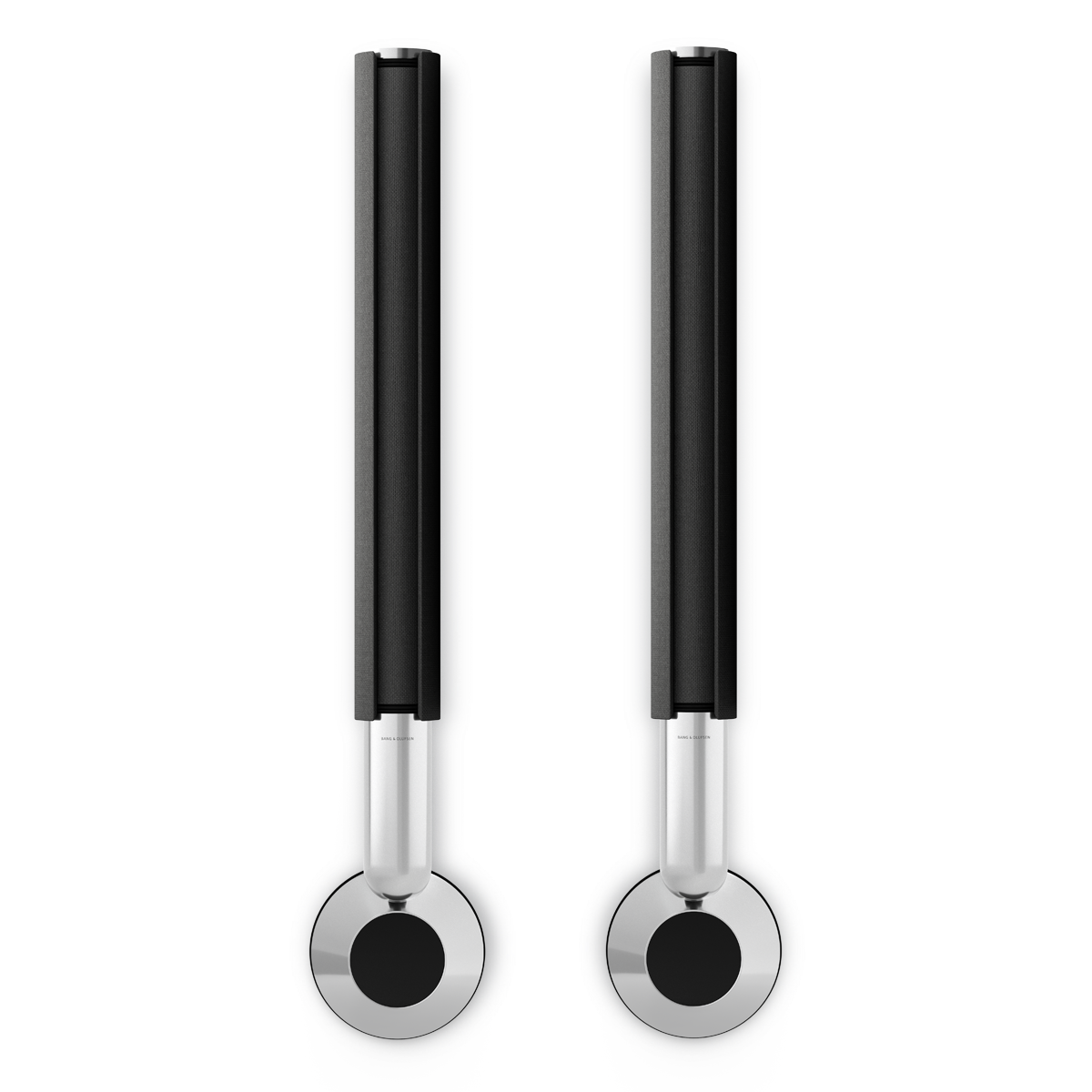
In most other respects, I preferred the sound of the Beolabs to my own system. Think about that. On the one hand, you have a carefully assembled component system that’s been tuned to the nines. On the other, you have a lifestyle system that’s a masterpiece of industrial design. The active Elacs are attractive in their own way; but in terms of design, craftsmanship, and materials, the Beolabs are in a different league altogether. And sonically, the Beolab speakers are more than competitive.
Even after a decade of listening, I expect owners of a pair of Beolab 28s will get a thrill of delight every time they see the speakers’ curtains parting, as if by magic, after they cue up some music on a smart device. And that thrill will continue as the tunes play.
. . . Gordon Brockhouse
Associated Equipment
- Active loudspeakers: Elac Navis ARF-51 with IsoAcoustics Gaia II isolators.
- Streaming DAC-preamp: NAD C 658.
- Subwoofer: SVS 3000 Micro.
- Sources and control devices: Apple Mac Mini computer (mid-2011) running Roon Core 1.8, HP Spectre x360 Windows convertible laptop running Roon Control 1.8 and Audirvana 3.5.51, Apple iPhone 8 and Google Pixel 4a (5G) smartphones.
- Network: Google Wifi four-node mesh network.
Bang & Olufsen Beolab 28 Active Loudspeakers
Price: $16,500/pair with slatted wood outer covers; $14,750/pair for models with fabric outer covers. Add $900 for Beoremote Halo controller.
Warranty: Three years, parts and labor.
Bang & Olufsen A/S
Bang og Olufsen Allé 1
7600 Struer
Denmark
Phone: +45 96 84 11 22
Website: www.bang-olufsen.com



